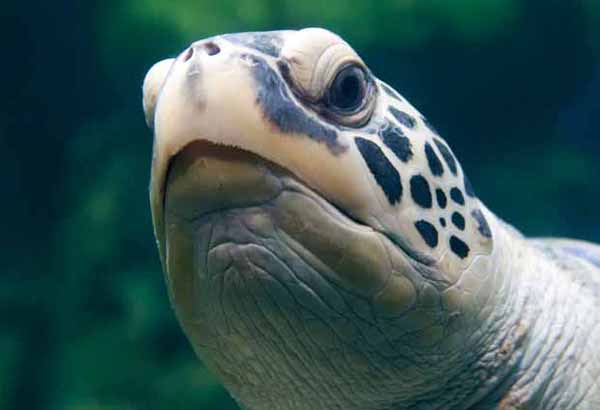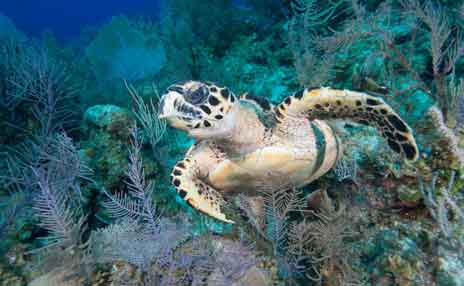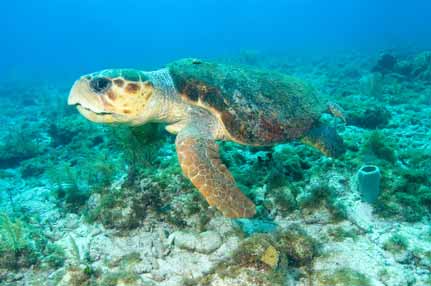Food Preferences & Resources
Diet varies with species. Sea turtles may be carnivorous (meat eating), herbivorous (plant eating), or omnivorous (eating both meat and plants). The jaw structure of many species indicates their diet.
Some species change eating habits as they age. For example, green sea turtles are mainly carnivorous from hatching until juvenile size; then progressively shift to an herbivorous diet.
Green sea turtles have finely serrated jaws adapted for a mostly vegetarian diet of sea grasses and algae. As adults, these are the only predominantly herbivorous sea turtles; although some occasionally also dine on jellyfish and sponges.

Green sea turtles have finely serrated jaws to accommodate their herbivorous diet.
Some species change eating habits as they age. For example, green sea turtles are mainly carnivorous from hatching until juvenile size; they then progressively shift to an herbivorous diet.
A hawksbill has a narrow head with jaws meeting at an acute angle, adapted for getting food from crevices in coral reefs. They mainly eat sponges, but also occasionally a small amount of tunicates, shrimps and squids.
- The digestive systems of adult hawksbills are able to neutralize the sharp, glass spicules (small structural elements), and toxic chemicals found in many of the sponges they consume. Sponges provide hawksbills with a food source few other animals can ingest. This also can make hawksbills toxic for humans to eat.
- An adult hawksbill in the Caribbean can eat 544 kg (1,200 lbs.) of sponges a year. Hawksbills help maintain healthy coral reefs by keeping sponge growth in check, which allows plenty of space and sunlight for corals to flourish.


The hawksbill sea turtle has a narrow head adapted for getting food from crevices in coral reefs. The jaws of a loggerhead sea turtle are adapted for crushing and grinding.
Loggerheads', Kemp's ridleys', and olive ridleys have jaws that are well adapted for crushing and grinding. Their diet consists primarily of crabs, mollusks, shrimps, jellyfish, and vegetation.
Leatherbacks have delicate scissor-like jaws that would be damaged by anything other than their normal diet of jellyfish, tunicates, and other soft-bodied animals. The mouth cavity and throat are lined with papillae (spine-like projections) pointed backward to help them swallow soft foods.
Flatbacks have slightly serrated lower jaws and consume a wide variety of marine invertebrates including jellyfish, sea cucumbers, shrimp, mollusks, and sea pens. They usually feed in shallow, soft-bottomed habitats and avoid rocky or coral reefs.